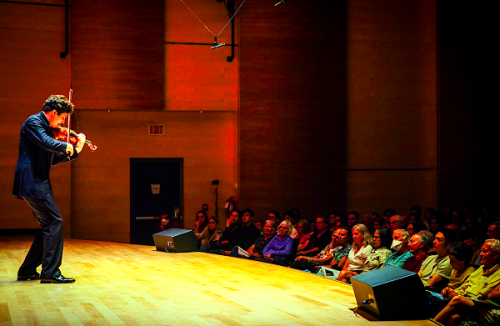
 United States Aspen Music Festival 2023 [5]: Harris Hall, Aspen, Colorado. [HS]
United States Aspen Music Festival 2023 [5]: Harris Hall, Aspen, Colorado. [HS]

There is nothing quite like Augustin Hadelich playing the violin all by himself, especially when it is the music of J. S. Bach for an unaccompanied string instrument. The Baroque composer, who showed the world how to create the illusion of a miniature orchestra, could make it seem as if several instruments were playing some of the most sublime counterpoint ever penned.
That is the magic. The hard part for the soloist is to make it feel natural instead of the technical challenge it actually is. In a jaw-dropping recital on Tuesday in Harris Hall, Hadelich not only brought these creations to life but made them sound utterly seamless. As if that were not enough, he delivered two twentieth-century works inspired by Bach, in their own savory and completely idiomatic style.
From two-dimensional notes on paper, Hadelich’s command of the violin expanded all these scores to four-dimensional marvels of sonic ingenuity. He pushed the limits of tonal color, dynamics, melodic line and pace to keep us on our toes and enchanted. In the perfect acoustics of the underground, 550-seat concert hall, every nuance range true, from the subtlest pianissimo to the grandest fortissimo arpeggios.
In the first piece, Bach’s Partita No.3 in E major, the sweet, gently rocking tempo of the loure and the graceful contrasts between the two minuets were especially fine. If the opening prelude and final gigue galloped so fast that they didn’t quite bounce like the dances Bach intended, such excesses served to frame the more modern pieces that followed.
In its brief six minutes, Coleridge-Taylor Perkinson’s Blue/s Forms demonstrated just how far Bach’s idea of assembling dance forms into a seriously expressive piece could stretch. Most astonishing was the swing and idiomatic style that Hadelich lavished on a marvelous 1972 compendium of syncopations, quick glissandos and, yes, blue notes.
He followed that with Eugène Ysaÿe’s second sonata for unaccompanied violin from 1924, which calls back to the opening tune of the Partita No.3. Hadelich made the capacity audience giggle as its melodic gestures quickly fragmented, mocking their familiarity. Soon the much-used ‘Dies Irae’ tune takes over, pointing to the mythic association between the violin and the devil. As mind-boggling as his execution of this music was, the best was the quiet second movement, ‘Malinconia’. The long, two-voiced respite from the bustle of the first movement finally gave way to a thrilling expansion on ‘Dies Irae’, a textbook demonstration of Hadelich’s wide emotional range.
Best of all was Bach’s Partita No.2 in D minor, which culminates with a majestic ten-minute Chaconne. Fiendishly difficult, the Chaconne is widely considered to be the pinnacle of violin music. The audience rewarded Hadelich’s almost-supernatural command of every phase with a carpet of silence, and the results could not have been more thrilling.
The encore spun out the Andante from Bach’s Sonata No.2 in A minor at a dignified pace, the ever-present eighth notes pulsing with just enough energy to let Bach’s endlessly inventive melodic variations and three- and four-voice counterpoint sing freely.
Thursday introduced a new piece, an Aspen Music Festival co-commission, composer Steven Mackey’s Joy Rhythm Study. It was written for the Brentano Quartet plus cellist Wilhelmina Smith, who had originally commissioned it for her Salt Bay Chamberfest in Maine. This quintet debuted the piece in August 2018 and played it again in Santa Fe in February 2020, before COVID canceled its scheduled Aspen debut that summer.
The three-year gap showed. It is a tricky piece: setting seven-beat rhythms against four was just one example of the timing challenges. Mackey’s score goes for a sort of loopy, snappy, dance form in which legs and arms seem to flail wildly. The music does indeed justify the title with a palpable sense of jubilation, but the musicians were tapping their feet and concentrating so seriously that the sense of wildness was missing. It did come together often enough to encourage further performances.
The quartet was not at its best, either, in the other piece on the program. They dug into Beethoven’s String Quartet in B-flat major and its unexpected tempo shifts and emotional sidesteps with careful attention. Unfortunately, there were too many points when the unanimity of articulation was not quite there.
Harvey Steiman
18.7.2023: Recital: Augustin Hadelich (violin)
J. S. Bach – Partita No.3 in E major for Unaccompanied Violin; Partita No.2 in D minor for Unaccompanied Violin
Perkinson – Blue/s Forms
Ysaÿe – Sonata No.2 in A minor for Unaccompanied Violin
20.7.2023: Recital: Brentano String Quartet / Mark Steinberg, Serena Canin (violins), Misha Amory (viola), Nina Maria Lee (cello)
Steven Mackey – Joy Rhythm Study, Wilhelmina Smith (cello)
Beethoven – String Quartet in B-flat major, Op.130
